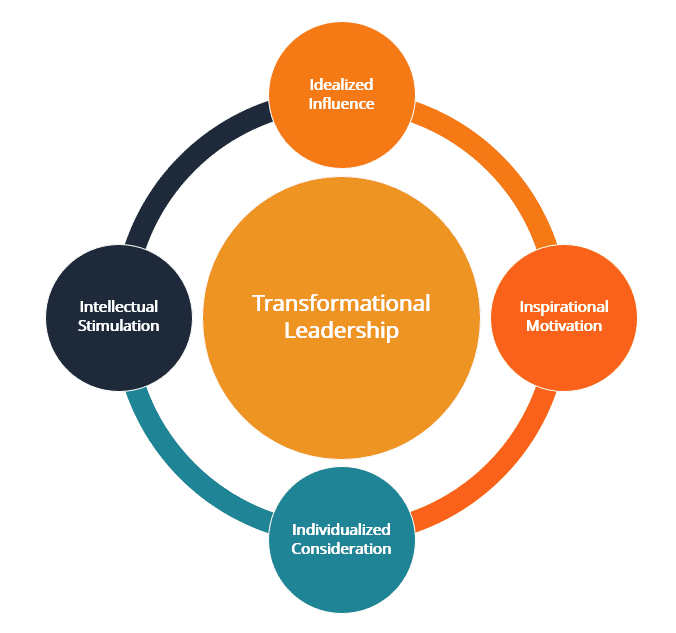
Navigating Project Success through Diverse Leadership Styles
Successful leaders are masters employing the diverse leadership styles tailored to the specific demands of each project. This article delves into the various leadership styles, exploring the common personality types, characteristics, habits, and optimal scenarios for the six distinct type of leaders.
1. Visionary Leadership: Paving the Path to Innovation
Characteristics: Visionary Leadership – Paving the Path to Innovation
Visionary Leaders stand out for their forward-thinking mindset and their innate ability to envision future possibilities. They are often the architects of groundbreaking solutions, propelled by a willingness to embrace calculated risks. These leaders thrive in ambiguity, turning challenges into opportunities through their innovative thinking. Visionary Leaders are not content with the status quo; instead, they constantly seek to push the boundaries of what is possible.
In addition to their innovative prowess, Visionary Leaders are adept risk-takers. Their calculated approach to risk involves a strategic evaluation of potential challenges and rewards, allowing them to make decisions that propel their vision forward. This risk-embracing quality sets them apart, as they understand that transformative change often requires stepping into uncharted territories.
Habits: Nurturing a Culture of Continuous Learning
Visionary Leaders cultivate a culture of continuous learning within their teams. Recognizing that innovation thrives on knowledge, these leaders stay abreast of industry trends, emerging technologies, and market insights. This commitment to ongoing education ensures that their vision remains aligned with the ever-evolving landscape of their industry.
Continuous learning for Visionary Leaders extends beyond personal development to fostering a learning environment within their teams. They encourage their team members to explore new ideas, experiment with innovative solutions, and share insights. By doing so, Visionary Leaders create a dynamic ecosystem where creativity flourishes, and the entire team is empowered to contribute to the realization of the shared vision.
Scenario: Navigating the Tech Revolution
Imagine a technology startup on a mission to revolutionize its industry. In this scenario, a Visionary Leader takes the helm, steering the company toward a future that transcends conventional boundaries. This leader paints a vivid picture of the company’s destiny, inspiring team members to embrace the challenges of a dynamic market. The Visionary Leader encourages the team to pursue innovative solutions, pushing the envelope of what technology can achieve. This scenario illustrates how Visionary Leadership can transform a startup into a trailblazer, where the team is united by a shared vision and driven to overcome obstacles on the path to innovation.
2. Transformational Leadership: Cultivating Growth and Inspiration
Characteristics: Transformational Leadership – Cultivating Growth and Inspiration
Transformational Leaders possess a unique ability to understand the emotions of their team, fostering a supportive and collaborative environment. These leaders are not just managers; they mentor, inspire, and guide their teams through challenges with empathy and a genuine understanding of individual and collective aspirations.

At the core of Transformational Leadership is the commitment to encouraging personal growth. Transformational Leaders recognize that the success of the team is intertwined with the personal and professional development of each member. These leaders foster an environment where team members are encouraged to stretch their capabilities and explore new horizons.
Transparent and genuine communication is a defining trait of Transformational Leaders. They communicate with authenticity, sharing both successes and challenges openly. This transparency builds trust within the team, creating an atmosphere where everyone feels valued and engaged.
Habits: Nurturing Growth through Feedback
Transformational Leaders are habitually engaged in providing regular feedback to their team members. This feedback encompasses both constructive insights and celebratory recognition. By actively acknowledging achievements, these leaders reinforce a positive team culture where successes are celebrated collectively.
Constructive feedback is a crucial element of Transformational Leadership. The habit of delivering feedback in a constructive manner creates an environment where team members feel supported and motivated to enhance their skills.
Scenario: Guiding Cultural Shift with Transformational Leadership
Consider a project requiring a significant cultural shift within an organization. In this scenario, a Transformational Leader steps forward to motivate the team to embrace change. The leader understands that cultural transformations demand more than just procedural adjustments; they require a collective commitment to a new mindset.
The Transformational Leader communicates the vision for the cultural shift with clarity and authenticity. Through transparent communication, they address concerns and highlight the positive aspects of the change. The empathetic connection with team members ensures that each individual feels heard and understood.
In this environment, the Transformational Leader fosters a collaborative ethos where each team member is encouraged to grow personally and professionally. Whether through skill-building initiatives, mentorship programs, or open forums for idea-sharing, this leader creates a space where individuals not only adapt to change but actively contribute to shaping the evolving culture. The scenario exemplifies how Transformational Leadership can be a guiding force in navigating complex organizational transformations while nurturing the growth and inspiration of each team member.
3. Servant Leadership: Putting the Team First
Characteristics: Servant Leadership – Putting the Team First
Servant Leaders are characterized by their unwavering commitment to prioritizing the well-being of their team members. They exhibit a deep sense of empathy and active listening, creating an environment where every team member feels heard and valued. Servant Leaders empower their teams by actively working to remove obstacles that hinder success. Their focus is not solely on achieving goals but on ensuring the growth, satisfaction, and success of each individual within the team.
Empowerment is a central theme in the characteristics of Servant Leadership. These leaders understand that by providing support and removing barriers, they create conditions for their team members to thrive. This approach fosters a sense of ownership and accountability, as team members feel empowered to contribute their best to the collective success.
Habits: Nurturing Growth through Mentorship
Mentorship and supportive leadership are foundational habits of Servant Leaders. They invest time and effort in the professional growth of their team members, recognizing that the success of the team is intrinsically tied to the development of each individual. This involves not only providing guidance but also creating opportunities for skill-building, career advancement, and personal development.
Supportive leadership, in the context of Servant Leadership, goes beyond offering encouragement. It involves actively providing the necessary resources for success. This could include training programs, access to relevant tools and technologies, or mentorship opportunities.
Scenario: Fostering Collaboration in Complexity
Imagine a complex project with diverse team dynamics, where multiple perspectives and skill sets converge for success. In this scenario, a Servant Leader emerges as a crucial guide. This leader creates a collaborative and inclusive environment by actively listening to team members and ensuring their needs are met.

The Servant Leader takes the time to understand the unique strengths and challenges of each team member. By doing so, they tailor their approach to leadership, providing personalized support and guidance. This level of individualized attention fosters a cohesive and successful team, where each member feels valued and understood.
In this collaborative environment, the Servant Leader actively works to remove obstacles that hinder team success. Whether addressing communication gaps, resolving conflicts, or providing resources, they create a space where every team member can contribute their best. Servant Leadership can be a transformative force in navigating complex projects, fostering a culture of inclusivity, collaboration, and individual growth.
4. Democratic Leadership: Fostering Inclusivity and Participation
Characteristics: Democratic Leadership – Fostering Inclusivity and Participation
Democratic Leaders distinguish themselves by involving team members in decision-making processes and valuing diverse perspectives. They believe in the strength of collective intelligence, recognizing that the input of every team member contributes to more robust and well-informed decisions. Adaptability and open communication are foundational to Democratic Leadership, creating an environment where team members feel empowered to voice their opinions and ideas.
Adaptability is a key characteristic of Democratic Leaders. They understand the dynamic nature of projects and industries, and their leadership style allows for flexibility in response to changing circumstances. This adaptability ensures that the team remains agile and can navigate evolving challenges with resilience.
Habits: Navigating with Regular Team Meetings
Regular team meetings and transparent communication are habitual in Democratic Leadership. These leaders actively seek input from team members, creating a forum for open discussions. Collective decision-making is a hallmark of this diverse leadership style, and leaders ensure that all voices are heard during the decision-making process.
Transparent communication is essential to maintain trust within the team. Democratic Leaders share information openly, ensuring that team members are well-informed about the project’s status, challenges, and goals. This transparency fosters a culture of openness, where everyone feels valued and engaged.
Scenario: Harnessing Diverse Perspectives for Success
Consider a project where diverse perspectives contribute significantly to success. In this scenario, a Democratic Leader takes the reins, facilitating open discussions and encouraging team input. This leadership style is particularly well-suited for industries where collaboration and inclusivity drive project outcomes.
The Democratic Leader initiates collaborative decision-making processes, actively involving team members in shaping project strategies. They recognize that the diverse experiences and perspectives within the team are assets that can be leveraged for innovative solutions. In this inclusive environment, team members feel empowered to share their insights, fostering a sense of ownership and collective responsibility.
Democratic Leadership can be a powerful force in projects where collaboration and diverse viewpoints are integral to success. By creating an open and participatory culture, Democratic Leaders harness the collective intelligence of their team, driving outcomes that reflect the richness of varied perspectives and ideas.
5. Transactional Leadership: Navigating Clear Expectations
Characteristics: Transactional Leadership – Navigating Clear Expectations
Transactional Leaders distinguish themselves by prioritizing clarity in expectations, setting measurable goals, and preferring structured approaches. They operate within well-defined frameworks, ensuring that team members understand their roles and responsibilities. This diverse leadership style thrives on tangible and measurable outcomes, with motivation often driven by rewards tied to performance.

The emphasis on clarity and structure is a defining characteristic of Transactional Leaders. They believe in setting clear expectations to guide the team toward success. By establishing measurable goals, these leaders provide a roadmap that team members can follow, fostering a sense of direction and purpose.
Motivation through tangible rewards is another key aspect of Transactional Leadership. Leaders in this style recognize that acknowledging achievements and providing concrete incentives contribute to sustained performance and commitment.
Habits: Guiding with Performance Reviews and Goal Setting
Transactional Leaders engage in routine habits such as performance reviews and goal setting. Performance reviews provide a structured platform for evaluating individual and team achievements, offering constructive feedback and recognition for a job well done. Goal setting is a habitual practice, ensuring that team members have clear objectives to work toward.
Recognition for achievements is a consistent habit of Transactional Leaders. Whether through formal acknowledgment or tangible rewards, these leaders ensure that the team’s efforts align with predefined benchmarks. This commitment to recognizing and rewarding performance fosters a culture of accountability and achievement.
Scenario: Efficiency in Structured Projects
Imagine a project with well-defined goals and structured tasks, where adherence to timelines and quality benchmarks is paramount. In this scenario, a Transactional Leader steps in to ensure the team operates efficiently. Clear expectations and tangible rewards become powerful motivators in driving performance.
The Transactional Leader establishes clear goals and expectations, outlining the parameters in which the team should operate. Regular performance reviews help monitor progress, providing feedback that guides continuous improvement. The leader ensures that individual and team achievements are recognized and rewarded, reinforcing a culture of accountability and goal attainment.
In this scenario, the Transactional Leader’s structured approach proves effective in navigating the complexities of the project. Team members are motivated to meet performance benchmarks, and the clarity in expectations facilitates a streamlined and efficient workflow. The Transactional Leadership style shines in projects where a well-defined framework and tangible outcomes are crucial for success.
6. Adaptive Leadership: Navigating Change with Agility
Characteristics: Adaptive Leadership – Navigating Change with Agility
Adaptive Leaders stand out for their agility, resilience, and innovative problem-solving capabilities. They possess a proactive mindset, embracing change with composure and remaining steadfast during periods of uncertainty. Characterized by flexibility and a willingness to evolve, Adaptive Leaders are well-suited for environments where change is constant, and challenges are dynamic.
Agility is a defining characteristic of Adaptive Leaders. They excel in navigating complex and rapidly changing landscapes, adjusting strategies and approaches to align with evolving circumstances. Their ability to embrace change as an opportunity rather than a hindrance sets them apart in dynamic industries.
Habits: Continuous Learning and Fostering Resilience
Continuous learning is a foundational habit of Adaptive Leaders. They stay informed about industry trends, emerging technologies, and market shifts, ensuring that their knowledge remains relevant and applicable. This commitment to ongoing education contributes to their adaptability, allowing them to anticipate changes and proactively adjust their approach.
Fostering team resilience is another key habit of Adaptive Leaders. Recognizing the challenges posed by uncertainty, they invest in building a resilient team that can withstand and overcome adversity. This involves creating a supportive culture, providing resources for skill development, and encouraging a mindset that views challenges as opportunities for growth.
Scenario: Guiding Success in Dynamic Environments
The Adaptive Leader takes charge, guiding the team through uncertainty with a strategic and composed approach. Their ability to adjust strategies and foster resilience positions the team for success in dynamic environments.

The Adaptive Leader encourages the team to embrace uncertainty, viewing it as an opportunity for innovation and growth. Through open communication and a proactive mindset, the leader instills confidence in the team, fostering a collective ability to adapt to evolving challenges.
The Adaptive Leader’s characteristics of agility and resilience leads the team through uncertainties, demonstrating that change can be navigated successfully with the right mindset. Adaptive Leadership is essential for projects in industries marked by rapid change, where the ability to adjust strategies and foster resilience is instrumental in achieving success.
Conclusion: Harmonizing Diverse Leadership Styles for Project Triumphs
Leaders are like conductors, harmonizing diverse leadership styles to navigate unique project requirements. By strategically applying the right leadership style at the right time, leaders guide their teams and cultivate environments conducive to innovation, collaboration, and success.

